Foot massage is a therapeutic technique that involves manipulating foot muscles‚ tendons‚ and ligaments to promote relaxation and well-being. It reduces stress‚ improves circulation‚ and eases pain‚ offering a natural way to rejuvenate both body and mind. Whether performed professionally or at home‚ foot massage is a simple yet effective self-care practice accessible to everyone.
What is Foot Massage?
Foot massage is a therapeutic practice involving the manipulation of foot muscles‚ tendons‚ and ligaments to promote relaxation and well-being. It combines gentle pressure‚ stretching‚ and rubbing techniques to target key areas like arches‚ heels‚ and toes. This natural healing method reduces stress‚ improves circulation‚ and alleviates pain. Whether performed professionally or at home‚ foot massage is a simple yet effective way to rejuvenate the body and mind. It often incorporates oils or lotions to enhance comfort and glide‚ making it a popular self-care ritual for overall health and relaxation.
Importance of Foot Massage in Self-Care
Foot massage is a vital component of self-care‚ offering numerous physical and emotional benefits. It reduces stress and anxiety by releasing tension stored in the feet‚ a common area for stress accumulation. Regular foot massages improve circulation‚ ensuring proper nutrient delivery to cells and organs. Additionally‚ it alleviates pain and discomfort‚ making it ideal for individuals with chronic conditions like arthritis. Foot massage also enhances overall well-being by promoting relaxation and emotional balance. Incorporating it into a self-care routine can lead to better mental health‚ improved sleep quality‚ and increased energy levels‚ making it a holistic practice for sustainable well-being.
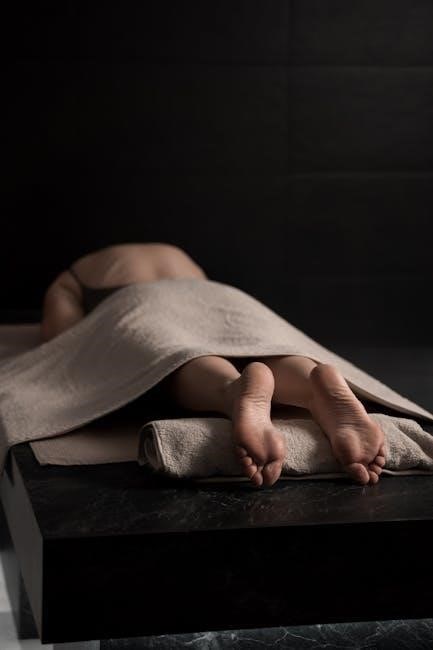
Benefits of Foot Massage
Foot massage reduces stress‚ improves circulation‚ and relieves pain‚ promoting overall well-being. It enhances relaxation‚ boosts mood‚ and increases energy‚ making it a valuable self-care practice.
Reducing Stress and Anxiety
Foot massage effectively reduces stress and anxiety by targeting pressure points that balance stress hormones‚ promoting deep relaxation. A 2018 study found that hand and foot massage lowers anxiety in patients and improves vital signs. The gentle pressure applied during the massage stimulates nerve endings‚ calming the nervous system and reducing tension. Regular foot massages can help alleviate emotional distress‚ offering a natural and comforting solution for mental well-being. This practice is particularly beneficial for individuals experiencing stress-related conditions‚ providing a soothing escape and fostering overall relaxation.
Improving Circulation
Foot massage enhances blood flow‚ delivering essential nutrients to cells and organs while aiding in toxin removal. By stimulating nerve endings and relaxing muscles‚ it boosts circulation‚ ensuring optimal oxygen and nutrient delivery; A study in the Journal of Clinical Epidemiology and Global Health found that regular foot massages can lower blood pressure‚ benefiting heart health. Improved circulation supports healing‚ maintains healthy tissues‚ and strengthens the immune system. Regular foot massages are particularly beneficial for individuals with circulatory issues‚ promoting overall well-being and energy levels through enhanced blood flow and proper bodily function.
Relieving Pain and Discomfort
Foot massage is an effective way to alleviate pain and discomfort‚ especially for those with conditions like arthritis or plantar fasciitis. By targeting pressure points and massaging sore areas‚ it reduces tension and inflammation. A 2016 review highlighted foot massage as a recommended pain management tool‚ even reducing the need for painkillers post-surgery. Gentle strokes and deep pressure techniques can provide immediate relief‚ while regular sessions can lead to long-term pain reduction. Incorporating reflexology further enhances these benefits‚ making foot massage a holistic approach to managing pain and improving quality of life.
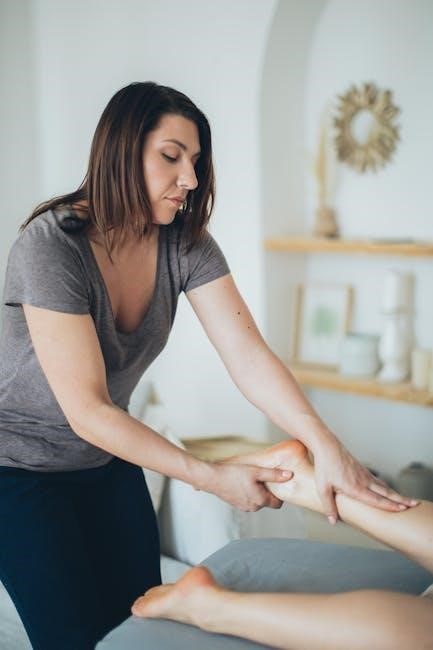
Preparation for a Foot Massage
Preparation involves creating a calm environment‚ gathering supplies like massage oil‚ and understanding the recipient’s preferences. Soak feet in warm water‚ pat dry‚ and use towels for comfort.
Creating a Calm and Relaxing Environment
Creating a serene atmosphere is essential for a foot massage. Dim the lights‚ play soothing music‚ and use scented candles or essential oils like lavender or peppermint to promote relaxation. Soak the feet in warm water with Epsom salts or citrus fruits beforehand to soften the skin and unwind the muscles. Pat the feet dry with a warm towel to enhance comfort. A peaceful environment helps the recipient let go of tension‚ making the massage more therapeutic and enjoyable. This setup lays the foundation for a rejuvenating experience‚ allowing both body and mind to relax deeply.
Essential Supplies for Foot Massage
Having the right supplies ensures a comfortable and effective foot massage. Start with a soft‚ clean towel to dry the feet after soaking. Use a high-quality massage oil or lotion to reduce friction and moisturize the skin. Essential oils like lavender or peppermint can enhance relaxation and reduce inflammation. Warm water with Epsom salts or citrus fruits is ideal for soaking feet to soften calluses and prepare the muscles. Keep extra towels on hand for drying and wiping excess lotion. These simple yet essential items create a professional-like experience‚ making the massage more enjoyable and therapeutic for the recipient.
Understanding the Recipient’s Preferences
Understanding the recipient’s preferences is crucial for a positive foot massage experience. Always ask about their comfort level‚ pressure tolerance‚ and specific areas they’d like focused on‚ such as the soles‚ arches‚ or toes. Some may prefer gentle strokes‚ while others appreciate deeper pressure. Open communication during the massage helps ensure the techniques and pressure are enjoyable. Be attentive to feedback and adjust your approach as needed. This personalized care enhances relaxation‚ making the session more effective and enjoyable for the recipient‚ while also building trust and connection.
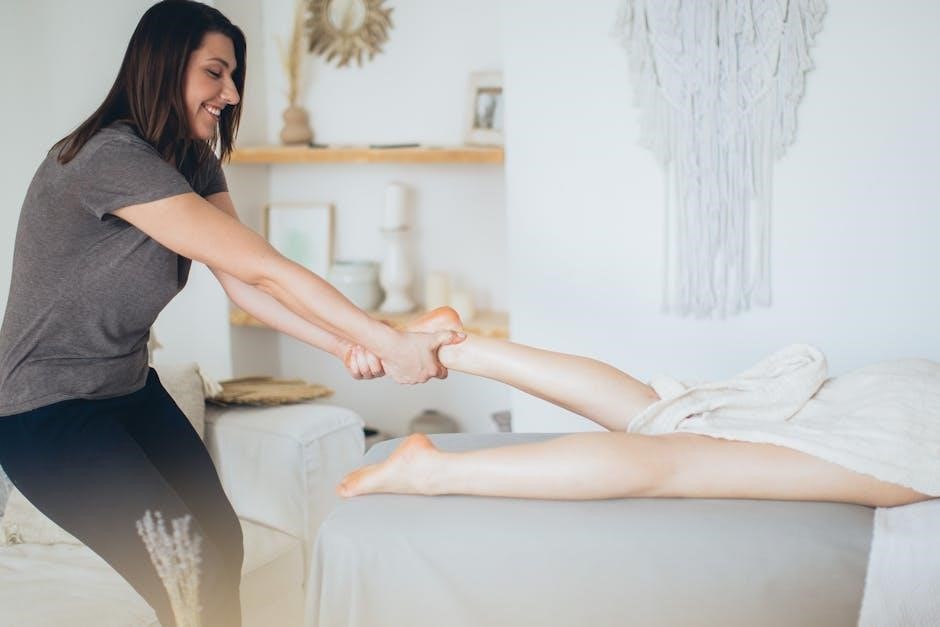
Basic Foot Massage Techniques
Basic foot massage techniques include warm-up stretches‚ applying pressure with thumbs‚ and using oil for smooth strokes. These methods promote relaxation‚ ease tension‚ and improve circulation effectively.
Warm-Up Stretches for the Feet
Begin the foot massage with gentle warm-up stretches to loosen the muscles and prepare the feet for deeper techniques. Start by gently pulling and pushing the sides of the foot‚ focusing on the toes and ankles. This helps increase blood flow and flexibility. Rotate each ankle clockwise and counterclockwise to release tension in the joints. Lightly stretch the toes apart and hold for a few seconds before releasing. These simple stretches not only relax the feet but also prevent soreness during the massage. Always start with light pressure and gradually increase as needed. Encourage the recipient to share any discomfort.
Applying Pressure with Your Thumbs
Use your thumbs to apply firm‚ steady pressure during the foot massage‚ focusing on key areas like the arches and heels. Start at the heel and work upward‚ using circular motions to target tense muscles. Apply pressure gradually‚ ensuring it’s comfortable for the recipient. To avoid strain‚ lean into the pressure with your body weight rather than relying solely on thumb strength. Vary the intensity based on feedback‚ lighter for sensitive areas and deeper for stubborn knots. This technique promotes circulation‚ relieves tension‚ and enhances relaxation‚ making it a cornerstone of an effective foot massage routine.
Massage Oil or Lotion Usage
Using massage oil or lotion is essential for a smooth and effective foot massage. It reduces friction‚ allowing your hands to glide effortlessly over the skin. Apply a small amount to your palms or directly to the feet‚ focusing on heels‚ arches‚ and toes. Choose a lotion or oil specifically designed for massages‚ as they are formulated to moisturize and soften calluses. Essential oils like lavender or peppermint can enhance relaxation and provide therapeutic benefits. Avoid using too much‚ as it may make the feet slippery. The right amount ensures optimal glide and comfort during the massage‚ improving the overall experience;
Targeting Key Areas: Heels‚ Arches‚ and Toes
Focus on the heels‚ arches‚ and toes for maximum relief. Use circular motions with your thumbs on the heels to soften calluses and improve circulation. For the arches‚ apply firm pressure in upward strokes to release tension. Gently squeeze and rotate each toe to enhance flexibility and reduce stiffness. Pay extra attention to the base of the toes‚ as this area is rich in nerve endings. By targeting these key areas‚ you can address common discomforts and promote overall foot health. This technique also aligns with reflexology principles‚ offering benefits beyond localized relaxation.
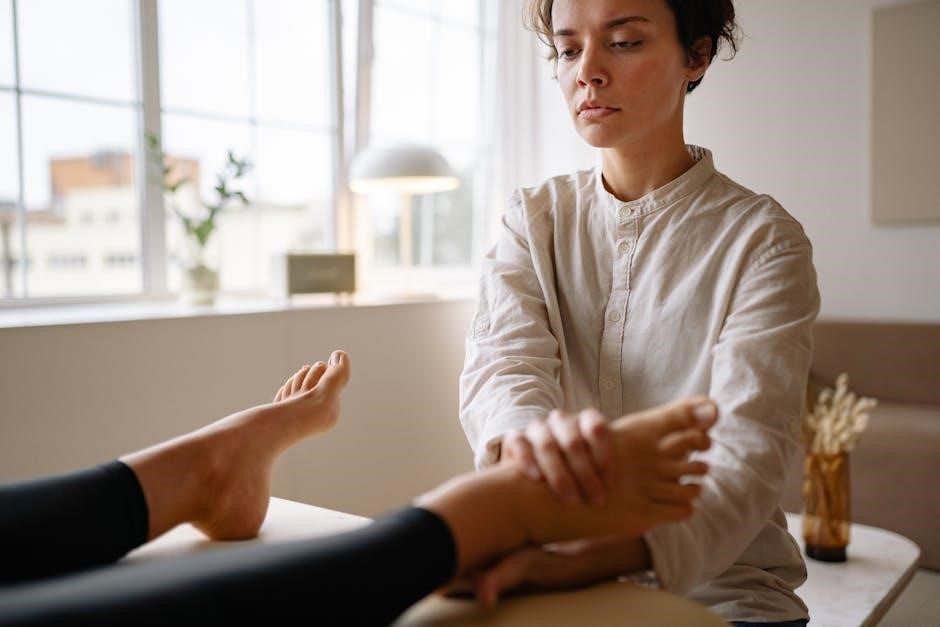
Reflexology Techniques in Foot Massage
Reflexology Techniques in Foot Massage
Reflexology is an ancient therapeutic practice based on the concept that specific pressure points on the feet correspond to organs and systems in the body. Originating over 5‚000 years ago‚ it aims to restore balance and promote well-being by stimulating these reflex zones. By applying targeted pressure‚ reflexology can enhance blood flow‚ reduce stress‚ and address various health issues. Often used alongside traditional therapies‚ reflexology is not a cure but a complementary approach to support overall health and relaxation. Its popularity stems from its holistic benefits‚ making it a valued addition to foot massage routines for both physical and emotional well-being.
Key Pressure Points for Common Health Issues
Specific pressure points on the feet target various health concerns. The big toe corresponds to the head and neck‚ alleviating headaches and sinus issues. The arch connects to the spine‚ aiding lower back pain. The ball of the foot links to the chest‚ benefiting heart and lung health. The heel associates with the pelvis and sciatic nerve‚ addressing lower back discomfort. The pinky toe side relates to the kidneys and adrenal glands‚ supporting urinary health. Massaging these zones can help alleviate common ailments‚ offering a natural approach to managing body-wide wellness through targeted pressure techniques in reflexology-based foot massage routines.
Connecting Foot Reflex Zones to Body Organs
Foot reflexology maps specific zones on the feet to organs and systems in the body. The toes correspond to the head‚ neck‚ and sinuses‚ while the ball of the foot connects to the chest and lungs. The arch links to the liver‚ pancreas‚ and kidneys‚ and the heel associates with the pelvic organs and lower back. By massaging these areas‚ you can stimulate the corresponding organs‚ promoting healing and balance. This ancient practice believes that pressure on these zones can improve organ function‚ reduce pain‚ and enhance overall well-being‚ offering a holistic approach to health through targeted foot massage techniques.
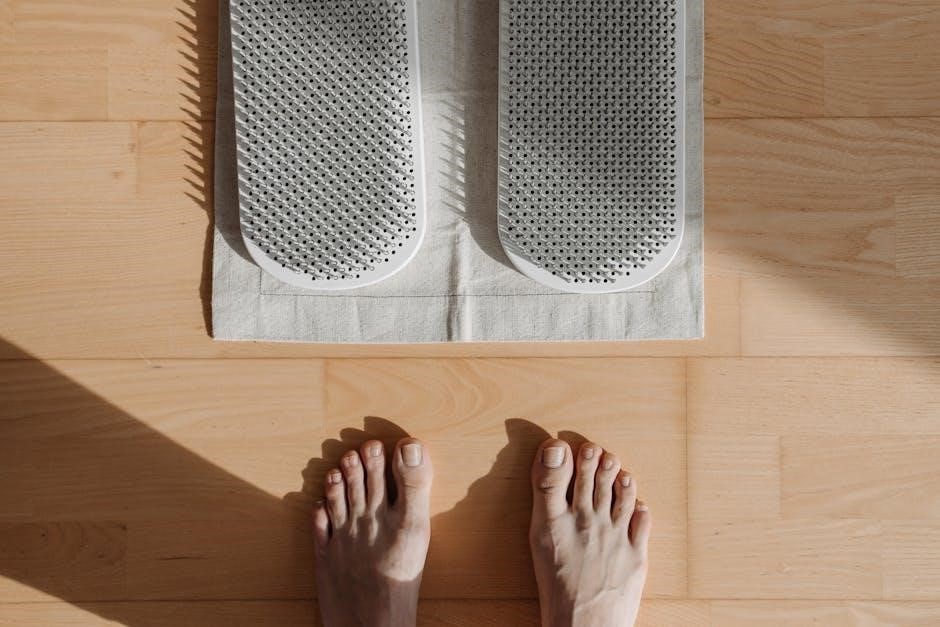
Advanced Foot Massage Tips
Advanced techniques involve using body weight for deeper pressure and incorporating reflexology for targeted relief‚ ensuring a more effective and rejuvenating foot massage experience.
Using Body Weight for Deeper Pressure
Using your body weight enhances foot massage by applying deeper pressure without straining your hands. Stand or position yourself to transfer weight onto your thumbs or palms. This technique allows for targeted pressure on areas like the arches and heels‚ providing relief from tension and knots. It’s especially effective for addressing chronic pain and stiffness. Always communicate with the recipient to ensure comfort and adjust pressure as needed. This method ensures a more intense yet controlled massage‚ making it ideal for those seeking deeper relaxation and therapeutic benefits.
Incorporating Reflexology into the Massage
Incorporating reflexology into your foot massage enhances its therapeutic benefits by targeting specific pressure points linked to body organs. By pressing these reflex zones‚ you can help improve organ function‚ reduce pain‚ and promote relaxation. Focus on areas like the heel for pelvic health or the arch for spinal alignment. Use firm‚ gentle pressure and circular motions to stimulate these points. This technique not only eases physical discomfort but also supports emotional well-being by balancing the body’s energy. Combining reflexology with massage deepens the experience‚ offering a holistic approach to health and relaxation.
Handling Sensitive or Sore Areas
When encountering sensitive or sore areas during a foot massage‚ gentle care is essential to avoid discomfort. Lightly massage around the tender spots‚ gradually increasing pressure if tolerated. Use soothing strokes and avoid direct pressure on painful areas. Communicate with the recipient to gauge their comfort level‚ adjusting your technique accordingly. Applying massage oil or lotion can reduce friction and provide a comforting glide. If pain persists‚ consider focusing on adjacent areas to promote relaxation without aggravating the soreness. Patience and sensitivity ensure a safe and enjoyable experience for the recipient.
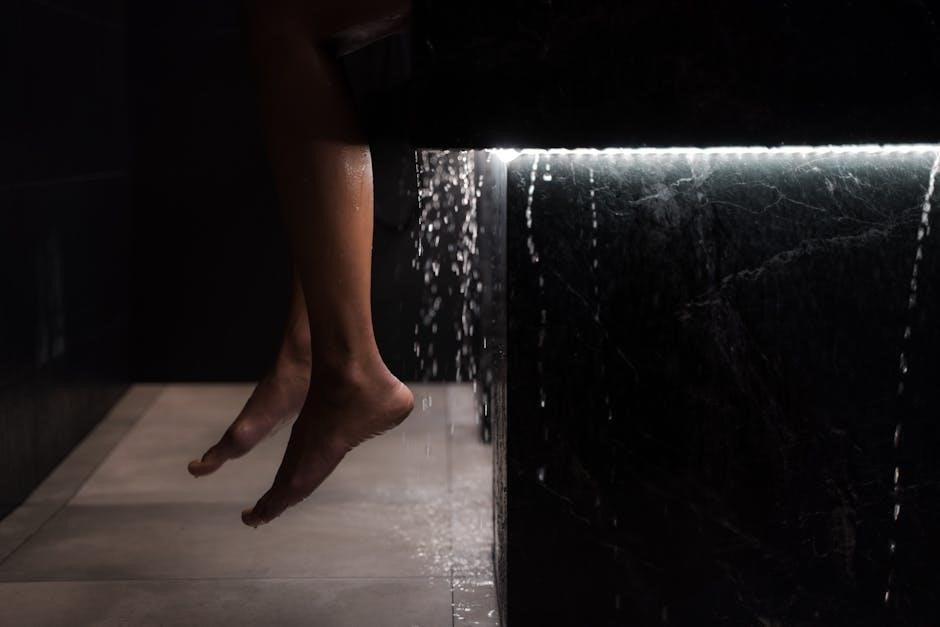
Aftercare and Follow-Up
After a foot massage‚ keep feet moisturized and encourage hydration. Ensure rest and consider follow-up sessions for sustained relaxation and well-being.
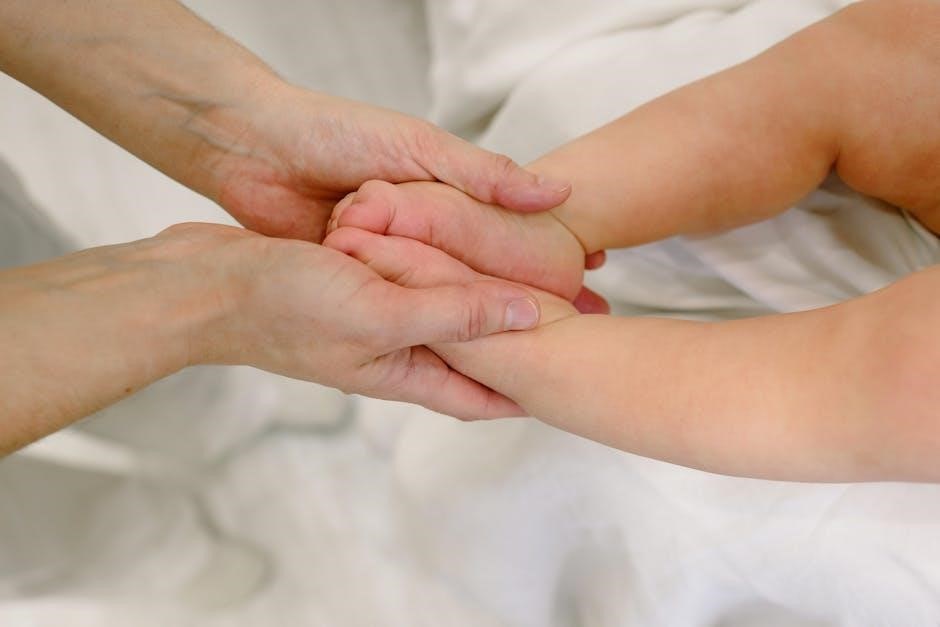
Keeping Feet Moisturized Post-Massage
After a foot massage‚ it’s essential to keep the feet moisturized to maintain softness and hydration. Use a rich lotion or cream‚ paying attention to heels and toes. This helps prevent dryness and cracking‚ ensuring the skin remains supple. Regular moisturizing also enhances the benefits of the massage‚ promoting long-term foot health and comfort. For best results‚ apply moisturizer immediately after the massage and reapply as needed throughout the day‚ especially before bedtime. This simple step complements the massage’s therapeutic effects‚ leaving feet feeling pampered and refreshed.
Encouraging Relaxation and Hydration
After a foot massage‚ encourage the recipient to relax and hydrate to enhance the benefits. Suggest activities like a warm bath or a nap to promote further relaxation. Offer water to keep them hydrated‚ as this helps flush out toxins released during the massage. Create a calming environment with soft music or scented candles to extend the therapeutic experience. Check for any remaining discomfort and adjust your approach if needed. Regular hydration and relaxation practices complement the massage‚ ensuring long-term well-being and a refreshed‚ rejuvenated feeling.
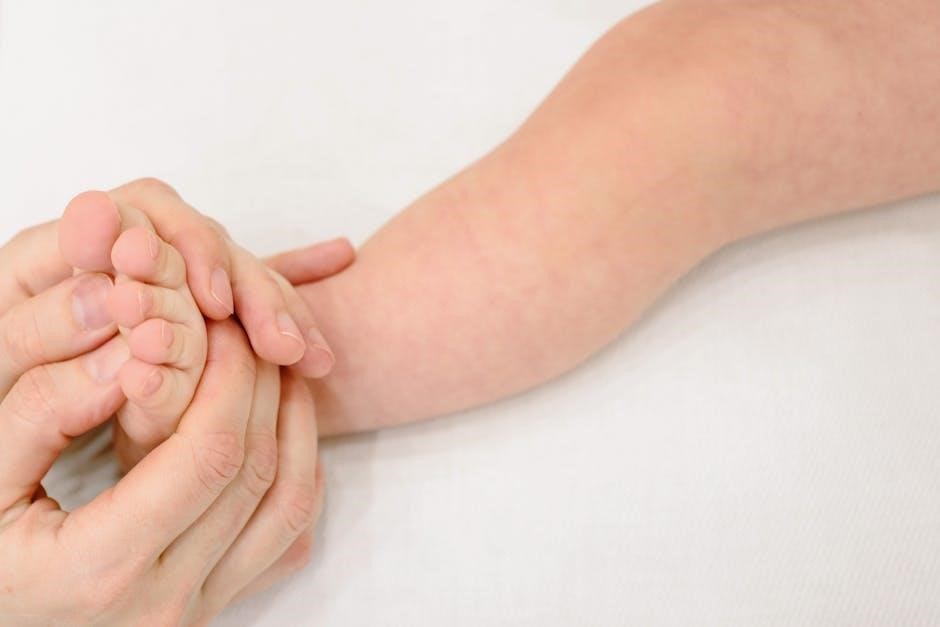
Frequency and Consistency
Consistency is key to maximizing the benefits of foot massage. Regular sessions‚ even a few times a week‚ can enhance relaxation‚ improve circulation‚ and reduce pain over time.
How Often Should You Give or Receive a Foot Massage?
Foot massages can be incorporated into your routine as often as needed for relaxation and pain relief. For general well-being‚ weekly sessions are recommended‚ while those with chronic pain or stress may benefit from more frequent massages‚ up to 2-3 times a week. Even short sessions of 10-15 minutes can be effective. Consistency is key to experiencing long-term benefits‚ such as improved circulation and reduced muscle tension. Adjust the frequency based on personal preferences and specific health needs to ensure the most enjoyable and therapeutic experience.
Building Foot Massage into Your Routine
Incorporating foot massage into your daily or weekly routine can enhance overall well-being. Start with short sessions of 10-20 minutes‚ gradually increasing as comfort allows. Consistency is key; aim for at least one massage per week. Use tools like rollers or lotions to make self-massage easier. Pairing foot massage with relaxation techniques‚ such as deep breathing or calming music‚ can deepen its benefits. Over time‚ regular practice can lead to improved circulation‚ reduced muscle tension‚ and a sense of calm. Make it a habit to prioritize your foot health and enjoy the long-term rewards of this simple yet powerful self-care practice.
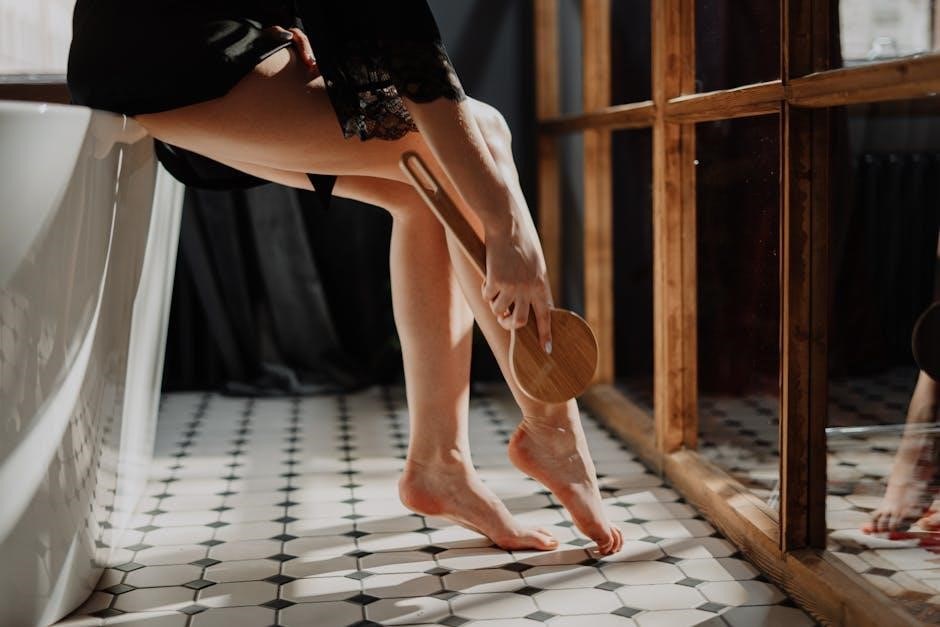
Using Tools for Foot Massage
Enhance your foot massage with tools like massage chairs‚ foot rollers‚ or DIY options such as tennis balls or foam rollers. These tools provide convenience and targeted pressure for effective self-massage and relaxation.
Massage Chairs and Foot Rollers
Massage chairs and foot rollers are excellent tools for self-massage‚ offering convenience and comfort. Massage chairs often feature rolling‚ kneading‚ and heating functions tailored for foot massage‚ while foot rollers provide targeted pressure and flexibility. They allow you to enjoy a spa-like experience at home without assistance. Using these tools regularly can help reduce muscle tension‚ improve circulation‚ and relax tired feet. They are ideal for incorporating foot massage into your routine‚ ensuring consistent care and relief from stress and discomfort. These tools enhance the massage experience‚ making it easy to maintain foot health and overall well-being.
DIY Tools for Self-Massage
For self-massage‚ DIY tools like tennis balls‚ foam rollers‚ and even rolling pins can be effective. A tennis ball can be rolled underfoot to target arches and heels‚ while a foam roller offers broader coverage. These tools allow you to apply pressure and relieve tension without assistance. They are cost-effective‚ accessible‚ and easy to use at home. By incorporating DIY tools into your routine‚ you can enjoy the benefits of foot massage anytime‚ enhancing circulation‚ reducing stress‚ and soothing sore feet. These simple tools make self-care convenient and empower you to take charge of your foot health.
Foot massage is an effective way to enhance relaxation‚ reduce stress‚ and improve overall well-being. Regular practice promotes long-term benefits‚ making it a valuable self-care routine.
Final Tips for Giving an Effective Foot Massage
Always communicate with the recipient to ensure comfort and adjust pressure as needed. Use high-quality massage oil to reduce friction and enhance relaxation. Focus on key areas like the heels and arches‚ where tension often builds. Vary your techniques‚ incorporating gentle strokes and deep pressure for a balanced experience. Encourage the recipient to breathe deeply and relax. After the massage‚ offer a warm towel or a refreshing drink to prolong the soothing effects. These final touches will leave the recipient feeling pampered and rejuvenated‚ making your foot massage truly unforgettable.
The Long-Term Benefits of Regular Foot Massage
Regular foot massage offers numerous long-term benefits‚ including improved circulation‚ reduced chronic pain‚ and enhanced overall well-being. It strengthens immune function by stimulating lymphatic drainage‚ promoting detoxification and reducing inflammation. Over time‚ it can also improve posture by releasing tension in the feet and ankles. Additionally‚ regular sessions may lower blood pressure‚ reduce stress hormones‚ and alleviate symptoms of conditions like arthritis and fibromyalgia. Incorporating foot massage into your routine fosters sustained relaxation‚ boosting mental health and emotional resilience‚ making it a valuable investment in long-term health and vitality.